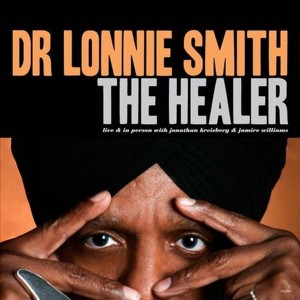A Prescription for feeling good, in a convenient capsule (review)
 Album Review: The Healer / Dr. Lonnie Smith Trio
Album Review: The Healer / Dr. Lonnie Smith Trio
By Todd Wetzel, director of Purdue Convocations
The legendary jazz-groove organist, Dr. Lonnie Smith, just released a stellar new album, The Healer, this past summer and, if you’ll excuse the pun, it’s truly a prescription for making you feel better. While the good Doc isn’t actually making a medical reference here when he titled the album as he did; instead he’s taking a more metaphorical route to lifting your spirits in such a way that allows you to leave your bad day at the office or current worries behind. And he does it by connecting the dots from the tradition of the classic Hammond B3 organ trios of the ’50s & ’60s to the grooving vibe of electronica and jam bands today with his wholly unique voice and musical curiosity intact.
If you’re willing to indulge me in a brief musical time-capsule, back in the ’50s the Hammond organ, known to many as the organ heard in everything from jazz clubs, rock bands, blues and R&B acts to gospel churches. The organ is inevitably paired with a large speaker cabinet possessing a rotating speaker that allows the organ to have the beautiful shimmery tremolo effect. If you think of Procol Harum’s 1967 hit “A Whiter Shade of Pale,” then you know exactly the sound in question: rich, full, percussive, and deeply emotive. In the hands of artists like Jimmy Smith, Wild Bill Davis, and Jimmy McGriff, and a host of others, the classic jazz organ trio format was established with organ, guitar and drums. That’s right, no bass player. Why? Because the organist covers the melodic content (chords and soloing) with the hands, and simultaneously lays down the bass lines with the feet. The music is certainly jazz, but it’s the connection to soul, R&B, and groove that became a defining essence for this configuration. Dr. Lonnie Smith made his move to New York after being picked up by the iconic guitarist George Benson when he needed a new organist, and this was all Smith needed to be on his way to soul jazz greatness collecting accolades such as “Top Organist” in the Downbeat magazine poll in 1969.
So now, in his seventh decade and with more than 70 albums under his belt, he could easily coast, but cutting a new live album with his sizzling trio and releasing it on his own brand new label doesn’t qualify for taking the easy road. This album captures the tasty chops of guitarist Jonathan Kriesberg and the flexible pulse of drummer Jamire Williams in the heat of all out, in-the-pocket grooves. Interestingly, the album opens with a laid back ballad that doesn’t give away everything that he has in store for you. The drums, while most definitely live and acoustic, almost have the sheen of electronica—precisely the type of music in which his iconic riffs have been so fondly sampled and redeployed. The return favor of hip acknowledgment is duly noted. It’s a track of simply, airy groove, and only half-way into the song, after a soulful exposition by Kriesberg, does Lonnie take over and start building, layer upon layer, a remarkable and powerful crescendo while Kriesberg amps up the support with wah-wah pedal punctuation. It all descends into a gentle restatement of the theme with Smith gently cooing along before the final cadence.
From there, the album kicks into an uptempo mode with “Mellow Mood” where the constant drive of the Williams’ ride cymbal holds down the pulse while Kriesberg develops a grooving jazz chordal pattern. Lonnie enters, nails the theme, and then darts off into ripping staccato support as the guitar solo unfolds. Dapper Dan, the third track, opens with yet another trademark opportunity to hear Smith build a groove from the ground up. Smith and Williams are simply telepathic in their rhythmic lockstep. There are moments here where Williams coaxes the backbeat out of the groove that echo, but never mimic, the killer funk jazz backbeat from the 1973 Herbie Hancock Headhunters era.
Smith enters the most straight ahead moment of the album with “Chelsea Bridge,” a gorgeously languorous ballad. This is the moment to take your iPhone and shove it into your purse or pocket, slow down, and let life unwind in a moment of crystalline, slow motion beauty. Even on a brief melodic crescendo, replete with Doc’s trademark stuttering chordal technique under the churning Leslie effect, the melody and emotional center of the song guide everything back down to a tender conclusion.
In “Beehive,” the album’s killer closing track, Smith lets loose on a brief synthesizer exposition that sets up a rapid-fire drum & bass pattern. As Doc tears into a ripping melody and a space guitar solo explodes underneath, you can easily see how current organ-based jam-bands like Medeski, Martin & Wood look to Smith as a wizard, not merely an inspiration. This is 10-plus minutes of powerful organ and guitar exchanges tethered by a crackling beat. As the song crashes to a finish, the crowd erupts into wild cheers, you’re reminded that for the last 40 minutes, Doc has indeed cured whatever ailed you.
Don’t miss the Dr. Lonnie Smith Trio
Featuring Dr. Lonnie Smith, Hammond B3 organ
Jonathan Kriesberg, guitar
Jamire Williams, drums
Friday, October 5, 2012, 8 PM
Long Center for the Performing Arts
Be sure to come early for a Pre-show talk: Don Seybold & Jamie Newman will discuss the Hammond B3 and the tradition of the jazz organ combo. 7 PM /Long Center.